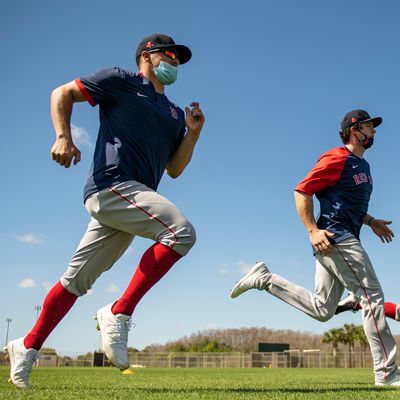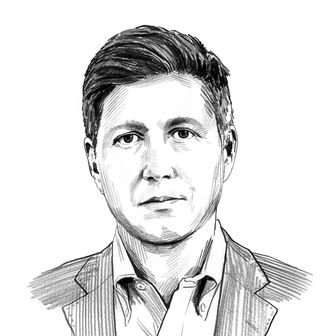
Last week, pitchers and catchers reported to spring training sites in Arizona and Florida, signifying the unofficial end of winter and the beginning of hope, renewal, and the relentless churn of 20-something men with terrible facial hair compulsively scratching and spitting. The sight of sunshine and freshly cut grass has always been a welcome respite from the snow and doldrums of late winter, but everything seems to shine even brighter this year. After a shortened season riddled with interruptions, reschedulings, and a COVID-19-positive guy roaming around the field unmasked at the World Series, MLB, as much as any sport in the country, is desperate to move on and move forward — at least until the looming labor disaster waiting for everyone in a few months.
The outsize importance of this season — scheduled to be completed in full this time, with fans in the stands and everything — was so apparent to MLB commissioner Rob Manfred that he attempted to push the start of spring training back a month to avoid surges of COVID cases in the Florida and Arizona areas (and also to try to jam through an expanded playoff structure). The players union, clearly gearing up for a fight this winter, didn’t budge on Manfred’s proposal, so spring training is starting on time, like it was supposed to. And, I have to say, it really does all seem very normal?
Sure, there are COVID-19 precautions everywhere. For years, one of the primary charms of spring training has been fans’ ability to wander around the backfields of team’s camps, watching them practice and reaching out for autographs; that’s over now, and the stands will have limited capacity at all Arizona and Florida fields. But otherwise, this feels like the beginning of any other season. Players are showing up and stretching, games will commence this weekend, and every teams’ fans think this is their year (except for Pittsburgh and Colorado). When last season finally began in late July, every game and every road trip sagged with anxiety and dread for the next round of player testing; at one point, with the season just a week old, Manfred even suggested the season would have to be canceled, and many media members (and the head of NYU’s Medical Ethics division!) agreed, scolding the league for ever trying to play in the first place. But there is no such existential peril this season. They’re going to play baseball.
And, for the first time in a long time, it’s not unreasonable to wonder: Why not? For all the worry of variants and surges in Florida and Arizona, COVID-19 cases are down to their lowest levels nationwide since before Halloween, and with the increased deployment of vaccines, there’s reason to hope this trend will continue. The Atlantic asked aloud last week if this might be “a quite possibly wonderful summer,” and, well, that’s the sort of phrase that’s music to Major League Baseball’s ears. (It certainly makes the idea of pushing spring training back a month seem a bit ridiculous, particularly if you buy that there could be another, smaller surge this fall.) It doesn’t look likely that we’re really going to get “herd immunity by April,” but MLB doesn’t need that: It only needs the pandemic situation to be better by then than it was this past August and September. It sure looks like that’s going to happen.
If it does, other sports can start to spread their wings. All you have to do is establish a baseline, and then expand; sports just needs the door to crack a little. What happened in Georgia way back in April is instructive. In the midst of prematurely reopening businesses around his state, Brian Kemp was the first governor to loosen restrictions on fitness centers — and, famously, bowling alleys and hair salons — which led the Atlanta Hawks to request that NBA commissioner Adam Silver allow them to open their practice facility. (After all, players have to train somewhere; wouldn’t it be better to have them to do so under the team umbrella than out in public?) Silver eventually granted their wish, and that was the first movement, however small, toward the NBA’s return. Next thing you knew there was a bubble in Florida, and now the NBA is just playing indoors everywhere. If you’re in New York, you can go watch the Knicks this week; in Atlanta, you can even scream in the players’ faces. If you give sports an inch, they will take a 100-yard touchdown dash. (Even if it means having fans attending indoor events, which certainly seems to be pushing the envelope a bit.) Pro sports has been barreling forward during COVID more aggressively than just about any other industry in the United States. You don’t expect them to slow down now that the pandemic is at its weakest point in months, do you?
Major League Baseball is the first sport to begin a second season amid the pandemic, and their restrictions are already far looser than when they started in 2020. The idea of having fans in the stands for a game at the beginning of last season would have been absurd; now it’s possible every team in baseball will welcome them, for better or worse. Based on the COVID rates among players themselves, it’s tough to blame MLB for being optimistic. When the 2020 baseball season began, intake testing upon arrival at camp showed 66 positive tests, a rate of 1.8 percent. This was seen as surprisingly low at the time, though still considerable reason for alarm, particularly since some teams had trouble getting their test results turned around in time. By contrast, when MLB and the players union announced the first round of intake testing results last week, the numbers of cases was downright minuscule: 13 positive tests, or “0.3% of the 4,336 total samples collected and tested.” We’d all love to live in a world where that number was zero. But the starting baseline is still dramatically better. And last year, MLB experienced no instances of on-field transmission, and went two months without a positive test until the Justin Turner fiasco in the World Series.
Which raises the question: Is this it? Is this really the end of COVID disrupting sports? The NBA is having its All-Star Game in two weeks; the MLS season is starting on time with its regular schedule; the NCAA Tournament is back on next month for the first time in two years (though given the constrictions of a precisely timed, 68-team event, things could get hairy). If conditions continue to improve, and we have our “quite possibly wonderful summer,” stands could be full by July everywhere. Sports will have made it. They will have gotten back to normal. They will have survived this.
There are still many questions the world of sports has to answer moving forward. That doesn’t mean everything is resolved. There’s an undeniable sense that sports have to make major inroads to get their fans back after this; ratings and interest have plummeted during the pandemic as Americans reprioritize their lives, and “watching millionaires run around in pajamas” has fallen down the list. But that was always going to be a challenge, post-pandemic. The question is whether that’s what we are nearing: the post-pandemic stage. As far as sports are concerned, we may already be there. And if we are … well, this might just be a quite wonderful summer indeed.






























